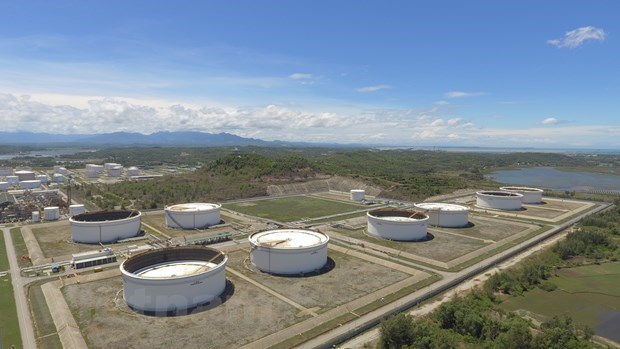Dung Quat Oil Refinery processes 53 percent of crude oil

Hanoi (VNA) - The crude distillation unit (CDU) at the Dung Quat Oil Refinery, located in the Dung Quat Economic Zone, Binh Son district, central Quang Ngai province, on February 10-13 processed 53 percent of imported crude oil for the first time.
The amount comprised 12 percent of US West Texas Intermediate (WTI) crude oil, 40 percent of Azeri Light (Azerbaijan) and 1 percent of Champion (Brunei).
In the first six months of this year, the plant aims to process five types of domestic oil exploited from Bach Ho (White Tiger), Heavy Bach Ho, Te Giac Trang (White Rhino), Su Tu Den (Black Lion) and Chim Sao (Blackbird) oilfields.
 Part of the Dung Quat Oil Refinery (Photo: VietnamPlus)
Part of the Dung Quat Oil Refinery (Photo: VietnamPlus)With import tax reduced to zero percent, the Binh Son Refining and Petrochemical Company (BSR) that operates the Dung Quat Oil Refinery has great opportunities to import crude oil from major sources such as Azeri Light and WTI.
Therefore, the BSR plans to increase imported crude oil to replace the decreasing domestic resources.
It has identified 67 types of crude oil that can be blended with Bach Ho crude oil, including nine domestic and 58 imported.
In reality, apart from Bach Ho, 19 types of crude oil have been processed, contributing to ensuring materials for Dung Quat Oil Refinery.
The SBR, a subsidiary of the Vietnam Oil and Gas Group (PetroVietnam), has reported gross revenue of 102.82 trillion VND (nearly 4.4 billion USD) in 2019.
According to a consolidated financial report released on January 20, the BSR’s after-tax profit hit more than 2.75 trillion VND, contributing over 9.7 billion VND to the State budget.
The firm’s equity increased from 31.37 trillion VND at the end of 2018 to over 33.9 trillion VND in 2019. Meanwhile, its liabilities decreased nearly 2 trillion VND to 19.5 trillion VND.
Total assets of the BSR stood at over 53.4 trillion VND.
In the first quarter of 2020, the company wants to ramp up operations at the Dung Quat Oil Refinery to its maximum capacity to complete its production targets for the year.
After 10 years, the Dung Quat Oil Refinery processed nearly 79 million tonnes of crude oil and sold 64 million tonnes of products, grossing over 1 quadrillion VND in revenue and contributing about 159 trillion VND to the State budget.
Dung Quat is the first-ever oil refinery in Vietnam with an annual capacity of 6.5 million tonnes of crude oil. The refinery applies cutting-edge technologies from the US and the EU and is capable of processing about 57 different types of crude oil with high API quality and low sulphur content.
The BSR has maintained the stable operation of the refinery at an average output of 103-105 percent of its designed capacity. The refinery uses 85 percent of locally-sourced materials and 15 per cent of imported materials.
In September 2019, BSR leaders met with potential partners such as Shell, Vitol, BP, PVOSN, PETCO, SOCAR, Glencore, Gazpromneft, Repsol and Sumitomo at the 35th Annual Asia Pacific Petroleum Conference in Singapore to seek cooperation opportunities.
Shell and BP representatives said they look forward to cooperating in supplying crude oil for the Dung Quat Oil Refinery, while SOCAR pledged a long-term supply of strategic Azeri crude oil to the refinery if the import tax for the product is adjusted to zero.
Vietnam’s self-sufficiency for crude oil could come to an end due to exploitation that could turn the country into a net importer of crude oil for the first time, experts warned.
According to analysts from the Fitch Solutions Macro Research, crude oil production in Vietnam would continue to drop over the coming years, averaging annual declines of 4-5 percent over the next 10 years, as offshore reserves fell and investment in significant new projects slowed.
Data from the General Statistics Office showed the country produced some 247,000 barrels per day (b/d) in 2018, a decrease of nearly 12 percent on year, some way short of State-owned Vietnam Oil and Gas Group (PetroVietnam)'s target of 14.2 million tonnes, equivalent to 285,000b/d.
PetroVietnam has maintained a pessimistic outlook towards the sector, forecasting in late-2018 its crude oil production to decline by as much as 10 percent annually to 2025, as output declines from some of its most mature domestic fields, namely Bach Ho - Vietnam's largest oilfield and responsible for 60 percent of total production./.












